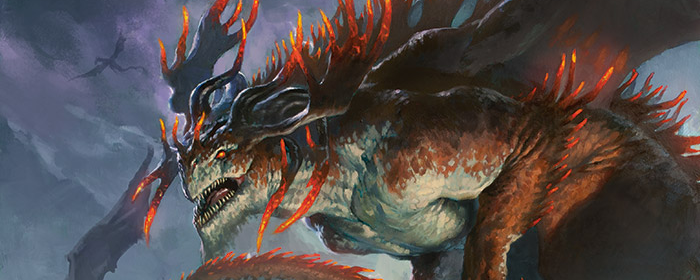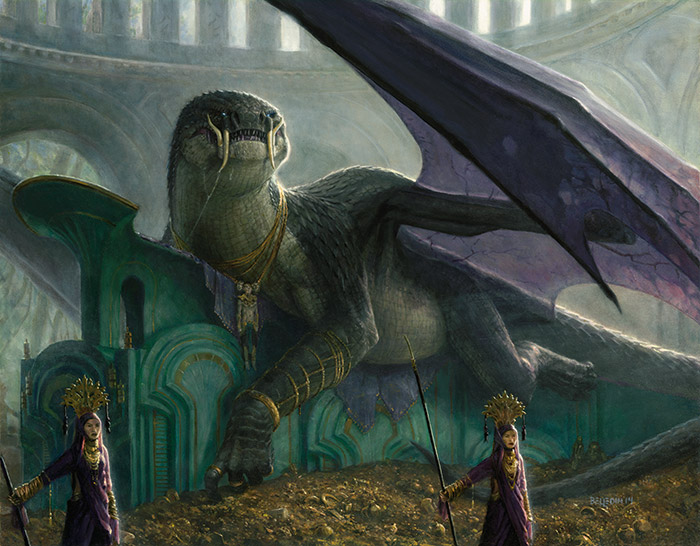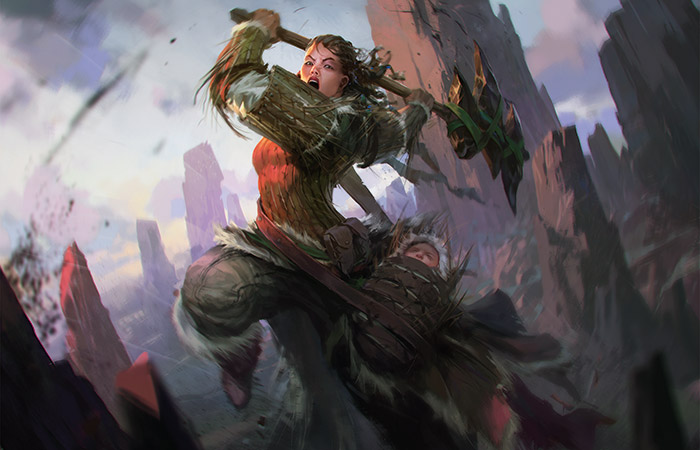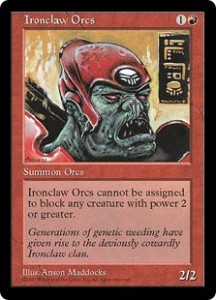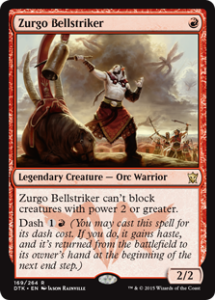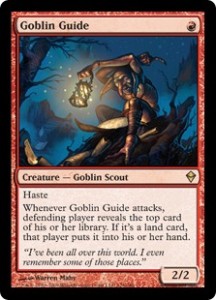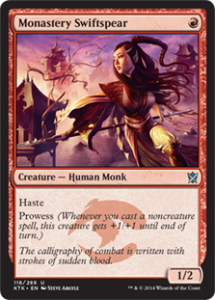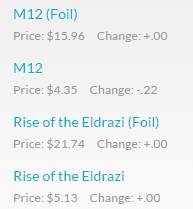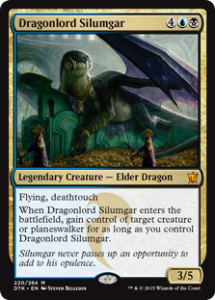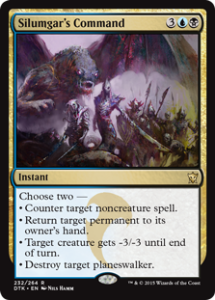The stage is set for an epic Top 8 bound to be remembered fondly both for the innovative deck lists and the quality of the talent.
Coming out of the Swiss rounds, here is where our Top 8 competitors ended up:
- Ondrej Strasky (GR Unwritten Atarka)
- Adrian Sullivan (UB Control)
- Martin Dang (RG Aggro)
- Jason Chung (RG Dragons)
- Shota Yasooka (UB Control)
- Marco Cammilluzzi (Abzan Control)
- Thomas Hendriks (GR Atarka)
- Andrew Ohischwanger (Esper Dragon Control)
Based on those results, here’s our Top 8 bracket:
- Hendricks (GR Atarka) vs. Sullivan (UB Control)
- Dang (RG Aggro) vs. Cammilluzzi (Abzan Control)
- Strasky (Atakra Unwritten) vs Ohischwanger (Esper Dragon Control)
- Shota (UB Dragon Control) vs. Jason Chung (RG Dragons)
Here’s a list of notable cards that made Top 8 this weekend with the number of copies on display:
- Whisperwood Elemental 8
- Xenagos the Reveler 8
- Goblin Rabblemaster 8
- Dig Through Time 8
- Nissa Worldwaker 7
- Dragonlord Atarka 7
- Ugin, Spirit Dragon 5
- Surrak, Caller of the Hunt 5
- Dragonlord Silumgar 4
- See the Unwritten 4
To summarize, the potential MTGFinance implications of this Top 8 as follows:
- If UB Control wins and it has dragons in it, expect Dragonlord Silumgar, Silumgar, the Drifting Death, Perilous Vault and/or Dig Through Time to potentially gain some ground.
- If Strasky manages to make Top 2, it would seem inevitable that See the Unwritten will dodge a price spike, especially given that the Eldrazi are inbound this fall to make the card even more alluring.
- If Hendricks pulls off a kill with Shaman of the Forgotten Way against Sullivan, look for that card to add some value.
- Dang and Hendricks are running a combined eight copies of Goblin Rabblemaster, so their success could lead to some renewed interest there. The Dang decks runs three copies of Zurgo, Bellstriker, so that could be a thing, and Atarka’s Command should gain $1-3 if Dang gets to the finals.
- Hendricks and Strasky are both running the full four copies of Whisperwood Elemental, so expect a boost if the card proves out to have enough power to win a major tournament in a completely different deck than in prior appearances.
Hendricks (GR Atarka) vs. Sullivan (UB Control)
Game 1: Under pressure and facing multiple threats, Sullivan gets off a key Crux of Fate to clear the deck in the mid-game. Whisperwood Elemental is countered on the next turn, and Sullivan starts in with a flurry of card draw spells to get back into control of the game. A main deck Ashiok starts claiming green creatures off the top of Hendricks deck and puts things away within a few more turns.
Game 2: Sullivan hastily mulligans a terrible hand. His next hand is 5 lands and a Silence the Believers, putting him on the back foot. Hendricks curves out nicely into Mystic, Caryatid and Courser into Genesis Hydra to get another Caryatid onto the table and starts generating constant pressure in the form of a steady stream of Coursers, Xenagos and a back pocket Nissa, Worldwaker. Sullivan tries to bluff an Aetherspouts to fend off a lethal attack, and does indeed manage to buy a turn to find a better answer. The top deck is a Perilous Vault, and without enough mana to play and activate it, Sullivan is forced to use a Silence the Believers with Strive to hold on through a 2nd turn of bluffing Aetherspouts. The next turn however only gives him an Ashiok and Hendriks takes Game 2 with a large attack force on the next turn.
Game 3: Hendriks decides to keep a hand with just a land and a Mystic, but draws land off the top to stay on pace. Hendriks runs out a Whisperwood Elemental on Turn 4, which catches an Hero’s Downfall immediately. Sullivan plays Thoughtseize on the next turn gaining valuable hand information and getting rid of Reclamation Sage to ensure his future Vaults do good work. A 2nd Whisperwood for Hendriks catches a Dissolve, and on the next turn cycle Hendriks offers a Course of Kruphix as counter/kill bait. It too catches a Dissolve with Sullivan sitting on Disdainful Stroke, Dragonlord’s Perogative and a Vault. A Dig Through Time puts Sullivan into the driver’s seat as he allows a Xenagos to resolve, only to follow it up with Perilous Vault on his turn. Sensing his doom, Hendriks casts a Genesis Hydra for 9 and puts Nissa, Worldwaker into play in order to ensure a Nissa generated land will be left behind after a Vault activation to clear the board. Sullivan bites and clears the board, aiming to Aetherspouts the 4/4 land a turn later as needed. A Stroke handles a top decked Xenagos, and Aetherspouts does indeed remove the last remaining threat from the GR mage. Perogative once again helps Sullivan take control, and Ugin drops into play to put our first UB player into the Top 4 within a few quick turns.
Dang (RG Aggro) vs. Cammilluzzi (Abzan Control)
Game 1: Dang leads off with his usual plan of low slung threats, with 3 creatures attacking for 5 on Turn 2. Our Abzan pilot Thoughtseize’s away Dragon Fodder on his second turn, but is down to 4 by Turn 3, and Dang steals the first game despite the presence of a Siege Rhino on curve. This is not the kind of start the UB Control players will want to face off against if Dang pushes through to further rounds!
Game 2: After sideboarding, Dang brings in 9 cards including four copies of Roast in exchange for Wild Slash to handle Siege Rhino and Whisperwood. Marco brings in 10 cards, including Bile Blight, three copies of Drown in Sorrow and three Fleecemane Lion as well as two copies of Duress to get token spells or Atarka’s Command. He boards out Ugin, Vess and Thoughtseize to speed up the deck.
After a fast curve out from Dang, Marco is facing elimination when he finds a land off the top and manages to clear the board with Drown in Sorrow and follow up on his next turn with a Siege Rhino. Dang however top decks Become Immense and kills his opponent in another game that took less than five minutes to play out.
Strasky (Atakra Unwritten) vs Ohischwanger (Esper Dragon Control)
Game 1: Strasky kicks off with an Elvish Mystic to start curving out after a mulligan from both players. Andrew takes Courser of Kruphix with Thoughtseize to slow things down. Strasky then offers up a Surrak, the Hunt Caller. A Foul Tongue Invocation from Andrew forces him to choose between his mana base vs. his only threat. He lets the Mystic die, and exposes himself to further removal. Sure enough a Downfall takes out Surrak and Strasky is left with a Morph and a Mystic, with a Boon Satyr in hand. Smart play with the Satyr on a Rattleclaw takes Andrew to 3, and he plays out Ojutai to attempt to stabilize. Strasky keeps the pressure on by forcing Ojutai to trade with his Mystic, leaving behind Polukranos, Boon Satyr and an Elvish Mystic against an empty board. It all comes down to an Anticipate looking for Crux of Fate, and failing to find it puts Atarka Unwritten up a game.
Game 2: Strasky brings in Nissa, Xenagos and Arbor Colossus. Atarka comes out. For Andrew, he brings in Ashiok and a small pile of singleton removal spells and the fourth copy of Thoughtseize. Strasky draws a great curve. Andrew gets a land heavy hand with very little action and fails to leave up a potentially key Silumgar’s Scorn to answer a Turn 2 Courser of Kruphix on Strasky’s second turn. On Turn 3, Scorn is held up, and Strasky opts to play Rattleclaw Mystic as a morph to avoid losing the turn to a counterspell. Perilous Vault comes out from Andrew, threatening to clear the board on turn five. With the UB mage tapped out Strasky drops Surrak and gets in for ten damage, putting Andrew to 9. The overwhelming board presence draws a Vault activation and Strasky gets to play Polukranos without worrying about it being countered. Ohlschwager uses Ultimate Price to keep the board clean. Strasky follows up with Elvish Mystic and a morph which are met by a Crux of Fate. Strasky declines to walk a Whisperwood Elemental into a potential counter, but drops Boon Satyr in at the end of his opponent’s turn. He then plays out Surrak, threatening 9 more hasty damage. Surrak catches a Hero’s Downfall, but Satyr gets in as Andrew casts Dig Through Time to try and set up a comeback. On his turn he casts Dragonlord Silumgar, steals the Satyr, and Ondrej is forced to try for Whisperwood into a Scorn. Silumgar and Satyr swing in, and Andrew then counters a responsive Arbor Colossus. Strasky top decks a Nissa at just one life and steals the game out from under his opponent despite tight play from Andrew!
Shota (UB Dragon Control) vs. Jason Chung (RG Dragons)
Game 1: Chung curves out normally with Heir of the Wilds into Boon Satyr. On turn four, Chung forces Yasooka to choose between countering his Thunderbreak Regent or killing an attacker. Yasooka chooses the counter option, and drops to 11. Facing a potentially hasty Surrak, the Japanese master user Downfall on Satyr to slow things down, and uses Crux of Fate to mop up on his turn. Chung is able to immediately field a Stormbreath Dragon, but Yasooka has another Downfall to stave off more damage, sitting at a perilous three life. Board parity established, Yasooka starts drawing cards and then plays his first threat in Icefall Regent to lock down a Rattleclaw Mystic. Chung draws into Draconic Roar but has no dragon to partner with it for the win. A Boon Satyr trades with the Regent and Shota gets off another DTT taking Silumgar, the Drifting Death and another Silumgar’s Scorn. A new Boon Satyr in the end step draws a Bile Blight and leaves Yasooka with four cards in hand. Scorn takes care of the next Stormbreath Dragon and Yasooka finds time to get Silumgar into play. In top deck mode Chung is hard pressed to table enough threats and Yasooka pulls away with Game 1, using his dragons to finish off his foe.
Game 2: Yasooka is forced to mulligan with one land but gets lucky as Chung fails to open with acclerants, holding 3 red dragons. Silumgar’s Scorn proves it’s mettle yet again, killing of the first Thunderbreak Regent that pops its head up. Bile Blight then cleans up a Boon Satyr but Chung answers with another Regent that is answered by Dragonlord Silumgar briefly before Chung uses Plummet to get his Regent back and swings for the win!
Game 3: Yasooka manages to answer a bevy of early threats only to use Dragonlord Silumgar to steal Xenagos and stabilize fully at ten life. With Chung running low on fresh threats, Shota sets off down the draw-go path, gets a Silumgar, the Drifting Death into play alongside his alternate self, backed up by counterspells and kill spells aplenty. Much to the dismay of the Kiwis, Chung falls to a masterful play pattern by Yasooka.
Quaterfinal Wrap Up
We’re down to the following decks: UB Dragon Control, RG Aggro, UB Control and Atarka Unwritten. For finance purposes we should now be laser focused on potential price movement on Dragonlord Silumgar, Dragonlord Atarka, Zurgo and Atarka’s Command. It’s also possible that camera time for Silumgar’s Scorn could move it into the $1-2 range from $.50.
Semifinals
Shota vs. Strasky
UB Dragons in the hands of Shota takes down Strasky to tear down the dream for See the Unwritten and Dragonlord Atarka just one round too soon. Again Dragonlord Silumgar has featured prominently and I’d be surprised for the card to not hit at least $8-10 despite only being a 1-2 of in most of the UB decks this weekend.
Finals: Dang vs. Yasooka
Game 1: The RG Aggro deck takes another Game 1 super quickly as Shota mulliganed hard and nearly caught a game loss because he had forgotten to de-sideboard after his last match. My eye turns to Atarka’s Command and
Game 2: Early Drown in Sorrow from Shota clears the board of red attackers and he follows up with an Icefall Regent and starts swinging. Eidolon of the Great Revel comes down, but Dragonlord Silumgar again shows up to steal it away and punish the red mage harshly and Shota runs away with it. I’m having trouble finding copies of the UB Dragonlord under $9 at this point, up $3 or so since the start of the weekend.
Game 3: Shota has 2 Status Dancer in hand after sideboarding, and is quickly facing down two Monastery Swiftspears. Drown in Sorrow clears the board yet again, but Dang plays out more threats than Shota can handle and takes the game.
Game 4: On the play Shota mulligans his first hand seeing too few answers to early plays. His next hand is 5 lands and Ultimate Price and Shota is easily in top deck mode. Ultimate Price takes out an early Eidolon, and Shota follows up with Virulent Plague, shutting down a ton of the token related cards in the red deck. Another Eidolon joins Swiftspear and Shota must take 2 more from the Eidolon while using Hero’s Downfall. Goblin Rabblemaster creates a fresh threat. Shota gets down a morphed Stratus Dancer, which can potentially counter a burn spell. It gets forced into blocking before it can gain more value however, Yasooka is down to lands in hand. Dang uses Atarka’s Command to put it away.
RG Aggro has won Pro Tour Dragons of Tarkir! Take a look at Zurgo, Bellstriker, Eidolon of the Great Revel, Atarka’s Command and Goblin Rabblemaster as potential spiking cards folks!
